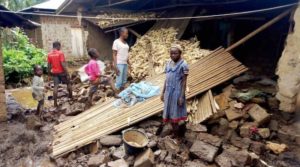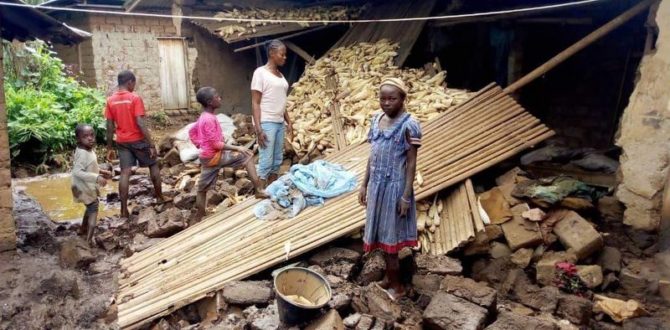- 60 Houses Swept Away
- 48 Families Homeless
- 4 Quarters Submerged again
- Fon Expresses Sympatry
BY NDIMUH B. SHANCHO
Close to seven years after a heavy flood swept across Babessi, one of the thirteen villages of the Ngoketunjia Division reducing some sixty houses to rubble and displacing at least 95 families, the village is once again plunged into another devastating incident.

On August 5, 2019 heavy rains accompanied by a storm, reportedly led to a flood that swept away some 60 houses, rendered 48 families homeless and submerged the Chui, Mbow, Mbezoh, and Abakwa neighbourhoods of the village.
The flood is also said to have washed away some 160 hectares of tilled land for the cultivation of rice, plantains, cocoyams, and beans.
Shortly after the floods, the traditional ruler of Babessi, Fon Oliver Tsodonebioh III, in a Face Book post, expressed his sympathy to victims of the natural disaster. “My heart goes to all the Babessi people who lost houses and properties due to floods resulting from severe rains in the community recently. I can imagine how painful the losses are, especially as it came during this challenging period with the damages to the Economy of the community amongst others, caused by the crisis in the English Speaking Regions of our Country,” the post reads.
The traditional ruler prayed to God to “give them the courage to bear the pains and recover from the losses”. He equally made an appeal for aids to be dispatched to his aggrieved subjects. “For those of you with kind hearts, the people will appreciate any support you can give no matter how small it is, especially during this challenging period,” he said
Chui, Abakwa Centre, Mbow and Mbezoh quarters repeatedly hit by floods, are said to be located around the Bamendjin Dam constructed on the Upper Noun River close to four decades ago. It is reported that when the construction of the dam was launched, there was a need to relocate those living on the risk line, but they were never moved. Instead, people from these neigbourhoods and some quarters in neigbouring villages like Bambalang, Bangolan, Baba I, and Bamunka and moved closer to an artificial lake behind the dam, which remains a mixed blessing; serving as a source of what is known in the area as “Bambalang fish” (a major source of income for the local population), a breeding ground for mosquitoes and making them susceptible to floods.







